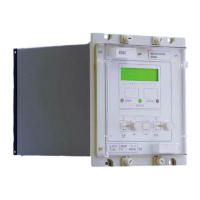Manual
KVCG202/EN M/H
7.4 Data for system integration
7.4.1 Relay address
The relay can have any address from 1 to 254 inclusive. Address 255 is the global
address that all relays, or other slave devices, respond to. The Courier protocol specifies
that no reply shall be issued by a slave device in response to a global message. This is
to prevent all devices responding and causing contention on the bus.
The relay is supplied with its address set to 255 to ensure that when connected to an
operational network they will not have a conflicting address with another device that are
already operational. To make the new devices fully operational they must have their
address set. The address can be changed manually by entering the password and
changing the address by the setting change method via the user interface on the front of
the relay.
Alternatively, if the software running on the PC supports “auto-addressing”, the relay
address can be set to “0” and the auto-addressing feature of the PC software turned on.
The relay will then be automatically set to the next available address on the bus. PAS&T
software supports both these feature.
If the address is 255, or unknown, the device address can be changed by sending a new
address, in a global message, to a device with a particular serial number. This method is
useful for devices that are not provided with a user interface with which to read the or
change the current address and is supported by both PAS&T, ACCESS and CourierCom.
7.4.2 Measured values
Any measured value can be extracted periodically by polling the relay. Measured values
are stored in the menu locations under column heading MEASURE.
7.4.3 Status word
A status byte is contained in every reply from a slave device. This is returned by the
relay at the start of every message to signal important data on which the Master Station
may be designed to respond automatically.
The flags contained are:
Bit 0 – 1 = Not used
Bit 1 – 1 = Plant status word changed
Bit 2 – 1 = Control status word changed
Bit 3 – 1 = Relay busy, cannot complete reply in time
Bit 4 – 1 = Relay out of service
Bit 5 – 1 = Event record available for retrieval
Bit 6 – 1 = Alarm LED lit
Bit 7 – 1 = Control LED lit
Bits 6 and 7 are used to mimic the alarm and control indication on the frontplate of the
slave devices. They cannot be used extract fault and alarm information from a slave
device because they cannot be guaranteed to be set for a long enough period to be
identified.
Bits 5 enable the master station to respond automatically and extract event records, if
they are so programmed so to do.
7.4.4 Plant status word
The plant status word can be found in menu cell 000C. It is used to transport plant status
information over the communication network. This feature is not used on KVGC202
relay.

